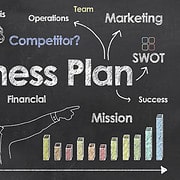A number of years ago a friend came up with a killer product idea targeted to fishermen. It was one of those devices that, when you think about it, makes you wonder why you didn’t come up with the idea yourself. I fully expected my friend to become a rich man. I planned to be there of course to remind him who his friends were when he was still “a nobody”.
He asked for my assistance in setting up his business and in designing his web site. Wanting a “piece of the action”, I of course agreed. My first request was “let me see your business plan”. To which he responded, “my what?” I managed to stifle a groan and instead offered to help him develop this crucial document. So we sat down together and came up with a three-page document.
The definition, and purpose, of a business plan is straightforward. It defines the goals and objectives of your intended business, and provides an outline of how you plan to get there. The plan we developed included that, along with an outline of how he was going to market the device. We left out the usual competitive analysis since his was a one of a kind product. We included a section that detailed how he would deliver the product. In his case, the best approach was the use of a 3rd party company for packaging and drop shipping.
My friend had not even considered a number of the items we incorporated into the final plan. Once completed however, the plan gave him a clear direction for operating his new business. He sold the device through his web site and did quite well. After 18 months, he received an offer for a buy out from a major fishing and outdoor product company. The deal was made and my friend walked away with a tidy sum of money.
Your business plan is an essential first step on your road to success. Making one up as you go along simply does not work. The plan provides a roadmap, and gives you a means to objectively analyze how effective your approach is. In a situation where you require a loan to launch your business, any bank or lender will require you to have a business plan.
The contents of a business plan can be as simple or complex as is required. For the vast majority or small businesses, a 5-10 page plan will usually suffice, depending of course on the business. While every business plan is a little different, the basic elements that need to be considered are:
- Executive Summary
- Business Description
- Marketing Strategies
- Competitive Analysis
- Operations Plan
- Management Plan
- Financial Plan
You will find that these elements are given different names depending on whom you talk to, and the order is not always the same. But none of that is the essential consideration. The key is that you have a plan.
The Executive Summary is no more than a few paragraphs outlining your overall goals and objectives, along with a synopsis of how you plan to arrive at those goals.
The Business Description identifies what you plan to sell or offer, and the strategies you will use to succeed.
The Marketing Strategies section details the vehicles you will use to achieve awareness of your product(s) and/or services. In the case of my friend’s business, we described how we would use not only the web site, but also print ads in several fishing magazines, along with fishing forums and newsgroups. This section also describes how you plan to brand your product. For my friend’s product, we came up with a very spiffy but easy to remember name. And of course, he knew he wanted a website.
The Competitive Analysis section identifies what other companies offer the same or a similar product(s), realistic pricing structures, and how you will attempt to set yourself apart. Setting yourself apart is particularly important in a competitive market.
The Operations section describes your approach to the day-to-day operations of the business. It should include all the mundane details from accounting to distribution channels.
The Management Plan describes your general approach to the management of your business. Remember, 90% of small businesses that fail, do so as a result of mismanagement or poor planning.
The Financial Plan section identifies your need for a business loan (if needed), and your plan for paying off that loan. It also includes information about your break-even points and return on investment (ROI).
Let me end this topic with a question: If you were going to have a home built, would you just let the trucks with the cement, 2x4s, shingles, wallboard, siding and so forth just pull up to your lot, and then have the builders proceed with no blueprint in hand? Would you just hope for the best that the toilet bowl doesn’t end up in the kitchen or the exterior door doesn’t end up in the attic? Of course you wouldn’t. No sane person would build a house without a detailed blueprint.
Then why would you do exactly that with your business? Your Business Plan IS your blueprint.


